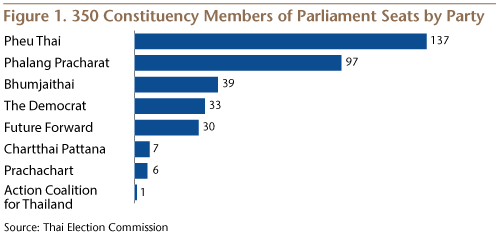Matthews Asia has been investing in Asia since 1991 and we draw on our experience to identify investment opportunities that stand to benefit from the development of markets throughout the region.
Key Developments from Thailand’s Election
April 2, 2019
On March 28, three days after the general election, Thailand's Election Commission (EC) finally announced the unofficial election results based on 100% of the votes cast. The Pheu Thai (PT) party, which is tied to the country's former leader Thaksin Shinawatra, became the country's single-largest political party, unofficially winning 137 parliament seats from 350 constituencies. Meanwhile, the Phalang Pracharath Party (PPRP), a newly formed party that represents the interests of the Thai military junta, finished second with 97 seats. PPRP won the popular vote, however, gathering 8.4 million votes nationwide compared to 7.9 million for Pheu Thai, on a turnout of 75%.
Official election results are expected to be announced May 9, 2019, as the remaining 150 seats will be allocated to political parties based on a proportional representation system linked to the nationwide popular vote. Given that a large number of irregularities have been reported, the actual proportional allocation is likely to fluctuate until 100% of the seats have been validated.
In the interim period, while the military junta continues as the caretaker government, both major winning parties in the election, PT and PPRP, are claiming the right to form a government. PT has allied with six other parties including the third-ranked party Future Forward to form a coalition. Following the EC's release of the unofficial full constituency results, however, the PT alliance has fallen short of a working majority with only 248 seats out of the total 500 in the Lower House (based on press calculations). Even if it is able to convince more small parties to join its coalition to make up a majority, the PT alliance will need 376 seats to be able to secure its choice of prime minister (as it may not receive support from the military-appointed Senate). This appears unlikely.
While there will be plenty of horse-trading in the weeks ahead to form a coalition, the likely core of a ruling coalition may be PPRP, the Democrat Party (DP) and Bhumjaithai (BJT). The DP and BJT won 52 and 49 seats, respectively and will be key to PPRP's ambitions to form a government. This core alliance would have 213 seats, still 36 seats short of a minimum 251 seat Lower House majority that is needed to pass legislation.
In order to make up the numbers, a long tail of small parties would have to join the coalition. This would make for an unwieldy and unstable coalition that would be unlikely to last a full term against a robust PT-led opposition. Since no formal coalition can be formed until after the official results are announced on May 9, however, we believe the current alliances will remain fluid. Combined with some disqualifications of elected MPs for electoral violations (the EC is investigating nearly 150 complaints), potential defections from various parties over the next several weeks could swell the PPRP coalition's ranks, allowing it to form a functioning majority.
Ultimately, if the Senate backs the PPRP to form a government, the military would essentially return in a more “democratic” guise, which would allow Thailand to normalize relations with the outside world and also provide continuity. That said, stability and continuity are likely to be sustained only if PPRP is able to build a solid coalition majority, as a minority government or an extended coalition with a weak majority would increase the risks of the government failing to last a full term.
The risk to this scenario is that there is a backlash in civil society against continued military influence in politics, mobilizing street demonstrations and raising the specter of instability. Local political experts see ultimately limited appetite for such actions, however, with the PT alliance more likely to fulfil the role of a strong opposition in the Lower House.
Sriyan Pietersz
Investment Strategist
Matthews Asia



